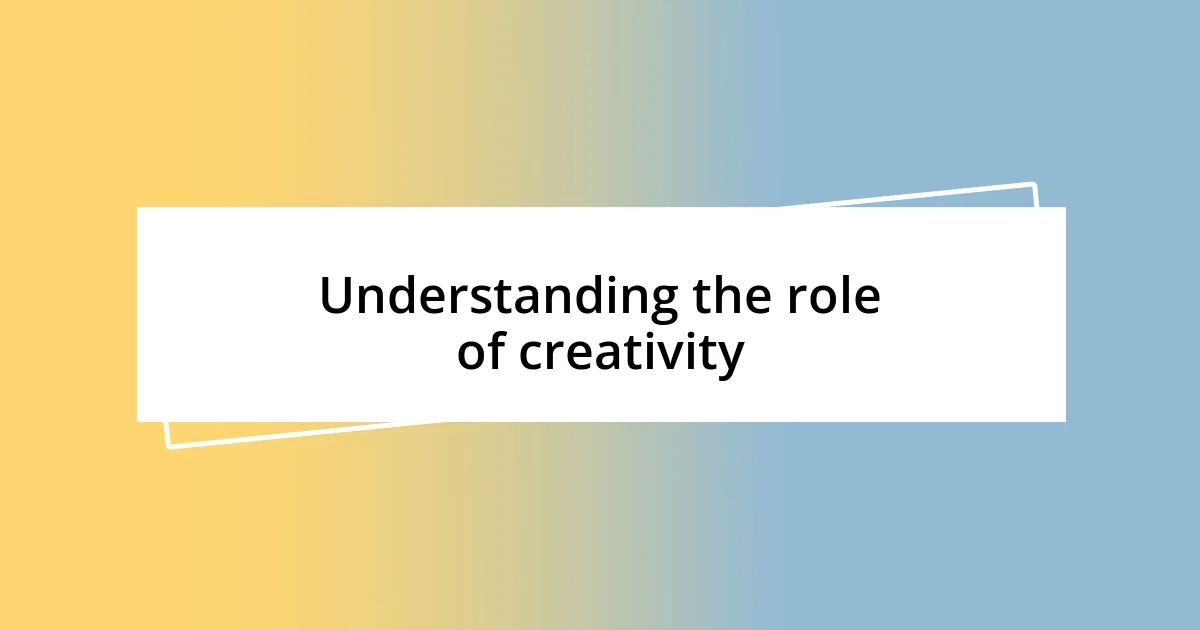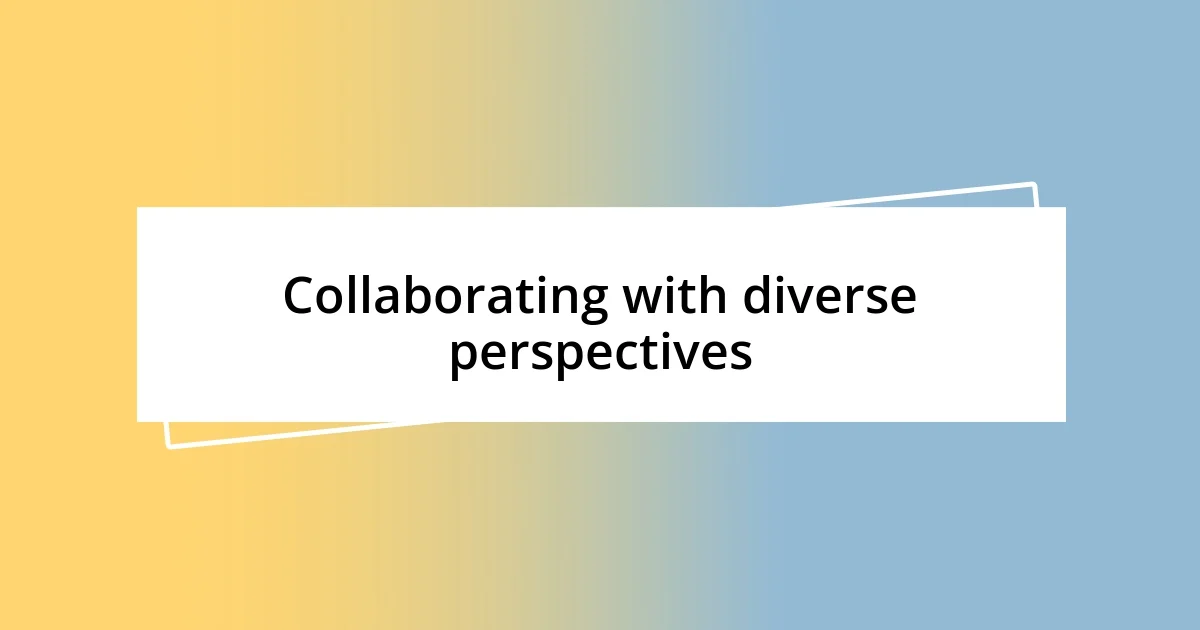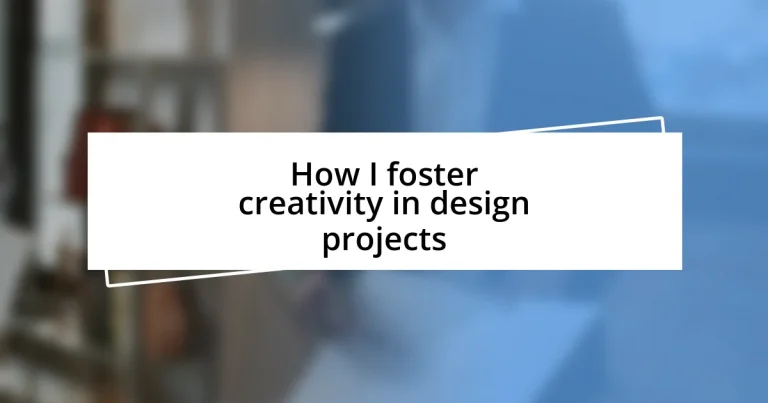Key takeaways:
- Emphasizing the importance of a creative environment, including elements like natural light, inspirational decor, and comfortable furniture, enhances collaboration and innovative thinking.
- Utilizing various brainstorming techniques, including leveraging constraints and changing perspectives, unlocks new ideas and fosters teamwork.
- Implementing feedback effectively by encouraging active listening and creating an inclusive atmosphere enriches design outcomes and nurtures creativity.

Understanding the role of creativity
Creativity plays a pivotal role in design projects, acting as the lifeblood that transforms mere ideas into impactful realities. I remember a project where I was tasked with revamping a brand’s identity. Initially, the concepts felt stale, but when I encouraged the team to brainstorm freely, their imaginative ideas sparked an entirely new direction—a testament to how creativity can lead to unexpected breakthroughs.
At times, I wonder if we truly grasp the full potential of creativity in our projects. Often, we box ourselves in with rigid frameworks, forgetting that some of the best solutions emerge from bending—or even breaking—the rules. These moments remind me of my earliest design days, where I dared to mix colors and forms without a safety net, discovering joy in the exploration itself.
Moreover, embracing creativity fosters collaboration and strengthens team dynamics. I’ve witnessed how sharing wild ideas can dissolve barriers, leading to a more open atmosphere where everyone feels valued and heard. Isn’t it incredible how a single creative spark can ignite passion and innovation among a group of diverse individuals? This collaborative energy is where the magic truly happens.

Creating an inspiring environment
Creating an inspiring environment is essential for unlocking creativity in design projects. I’ve found that the physical space plays a significant role in fostering innovative thinking. When I transformed my workspace by adding plants, vibrant artwork, and comfortable seating, I noticed an immediate shift in energy. My team felt more relaxed and open to sharing ideas, which, honestly, made discussing even the wildest concepts much more enjoyable.
To elevate your creative space, consider these elements:
- Natural Light: Maximize windows and open spaces to create a refreshing atmosphere.
- Inspirational Decor: Use art, quotes, or designs that resonate with your team and reflect your project’s goals.
- Comfortable Furniture: Ensure that seating is ergonomically sound yet cozy, inviting people to linger and collaborate.
- Flexibility: Designate areas for both focused work and casual brainstorming to cater to varying creative needs.
- Personal Touches: Allow team members to add their own flair to the space, making it a collective representation of your creativity.
Each of these touches can breathe life into a project, igniting sparks of inspiration that lead to brilliant outcomes.

Techniques to spark new ideas
When it comes to sparking new ideas, brainstorming is often the first technique that comes to mind. I find that gathering a diverse group and encouraging everyone to share their thoughts—no matter how wild—can lead to unexpected gems. For example, during a recent brainstorming session, we played a spontaneous game whereby each person built on the last idea, resulting in a truly unique design concept that none of us could have envisioned alone. Isn’t it fascinating how collaboration can lead to creativity that feels almost magical?
Another effective technique is leveraging constraints to fuel creativity. I’ve learned that by imposing specific limitations—like a tight budget or a narrowed design scope—my brain is forced to think outside the box. I remember a project where we had limited resources; instead of seeing it as a setback, I encouraged my team to view it as an opportunity. This shift in perspective not only fostered inventive solutions but also nurtured a sense of camaraderie as we tackled challenges together.
Finally, changing your perspective can unlock new avenues of thought. I often suggest that my team step into the shoes of different stakeholders, whether it’s the client, the end-user, or even a competitor. This technique has led to profound insights; once, while redesigning a product for kids, our team pretended to be children engaging with the toy. The result? Ideas that resonated deeply with our audience’s desires, making the design much more effective. Isn’t it enlightening how simply seeing things from a different angle can usher in fresh inspiration?
| Technique | Description |
|---|---|
| Brainstorming | Gather diverse ideas without judgment, encouraging all thoughts to inspire creative solutions. |
| Leveraging Constraints | Impose limitations that compel innovative thinking and foster teamwork in overcoming challenges. |
| Changing Perspectives | Consider the viewpoints of different stakeholders to discover unique insights and strengthen designs. |

Collaborating with diverse perspectives
The beauty of collaborating with diverse perspectives truly shines in the richness of ideas that emerge. I remember a project where we included people from different departments—marketing, engineering, and even customer service—in our initial discussions. It was eye-opening how each person brought a unique lens to the table. Have you ever experienced that moment when someone from an unexpected background offers an idea that suddenly makes everything click? It can feel like a puzzle piece falling into place, and it’s exhilarating.
In another instance, we worked with freelancers from various cultures. Their differing viewpoints added layers of depth to our design concepts. I still think about how one designer suggested incorporating a traditional pattern from her heritage, which sparked a series of designs that blended modern aesthetics with rich cultural history. This blend not only made the project more visually striking but also infused it with deeper meaning. Isn’t it amazing how a single perspective can expand the narrative of a design?
I’ve also learned that encouraging open dialogue is crucial when embracing diverse opinions. During one of our meetings, I posed a challenging question: “What if we had no budget constraints? How would we push our creative boundaries?” The room buzzed with enthusiasm. The ideas flowed freely, each one building on the last, and it became clear that the best concepts often emerge when everyone feels empowered to speak up. How do you foster an environment where everyone feels comfortable sharing their ideas? That, I believe, is where true creativity begins.

Using tools for creative thinking
Utilizing tools to foster creative thinking has become an essential part of my design process. For instance, I often turn to mind mapping software to visually organize thoughts and concepts. When I first started using this tool, I was astonished at how connections that I hadn’t seen before began to form. It’s like watching a web of creativity grow right before my eyes. Have you ever experienced that moment where an idea you thought was separate suddenly connects with another? It can be an exhilarating revelation.
Another tool that I’ve found particularly beneficial is collaborative platforms, such as digital whiteboards. During a recent project, my team and I used one of these tools to collectively sketch out our ideas in real-time. The excitement in the room was palpable as we could all contribute simultaneously, seeing our thoughts materialize on screen. This immediate feedback loop often leads to rapid iterations of design ideas, which feels almost electric. Can you imagine being able to engage and refine thoughts instantly with your team?
Lastly, I’ve been exploring the world of creative prompts—an unassuming yet powerful tool. I remember one day, feeling a bit stuck on a project, I decided to draw a random prompt from a jar filled with quirky ideas. The prompt was to design something inspired by the concept of “time.” This playful challenge led me down a rabbit hole of innovative thoughts about clocks, movement, and even transformations in design. This playful approach can break the monotony and lead to unexpected, delightful outcomes. How often do you allow yourself the freedom to play with ideas?

Implementing feedback effectively
Implementing feedback effectively is a nuanced art that can significantly elevate a design project. I vividly recall a specific instance when I received feedback from a client that wasn’t what I anticipated. Instead of becoming defensive, I approached it as an opportunity. We sat down together, navigating through their objections thoughtfully. It turned out that their concerns stemmed from a misunderstanding. This open exchange not only deepened our collaboration but also led to a design that resonated more profoundly with their vision.
Active listening is a game-changer when it comes to feedback. Early in my career, I often rushed to respond to critiques instead of taking a moment to fully absorb them. I learned the hard way that pausing to digest feedback before responding opens doors to deeper insights. Now, when someone offers input, I make it a point to paraphrase their thoughts to show understanding. How often do we leap into solutions without fully grasping the problem? Taking that moment can transform a simple comment into a catalyst for creativity.
Another key aspect is creating an environment that encourages constructive criticism. I remember hosting a feedback session where I emphasized that every opinion was valued, regardless of title or experience. As we went around the room, the quietest voices revealed powerful insights that had previously gone unheard. Isn’t it incredible how simply inviting participation can unearth gems of creativity? By nurturing this inclusive atmosphere, I’ve seen my projects flourish, as diverse thoughts weave into a richer tapestry of design.

Measuring creativity in design projects
Measuring creativity in design projects can feel elusive, but I’ve discovered some methods that bring clarity. One of my favorites is using a scoring system that encompasses various creative elements, such as originality, impact, and feasibility. I vividly recall a project where we quantified our ideas on these parameters, which revealed surprising insights into aspects we hadn’t prioritized. Have you ever found that taking a step back to evaluate can bring a fresh perspective?
Another approach I’ve found useful involves the concept of peer review sessions. I once facilitated a workshop where colleagues shared their designs in groups, and we critiqued each other’s projects based on creativity metrics we established together. This collaboration led to moments of vulnerability and honed our ability to perceive creativity from different angles. It felt almost like unlocking a treasure chest of ideas. How often do you seek external viewpoints to measure and expand your creative vision?
Finally, I recommend using qualitative feedback as a gauge for creativity. After presenting a design, I often ask specific open-ended questions that prompt my audience to reflect on their emotional responses. I remember one instance where a simple inquiry about what the design made them feel led to a passionate discussion that deepened the project’s meaning. Isn’t it fascinating how emotions can be a compass for creative success? Through these conversations, I’ve learned that measuring creativity isn’t just about numbers; it’s about understanding the emotional resonance of a design.













